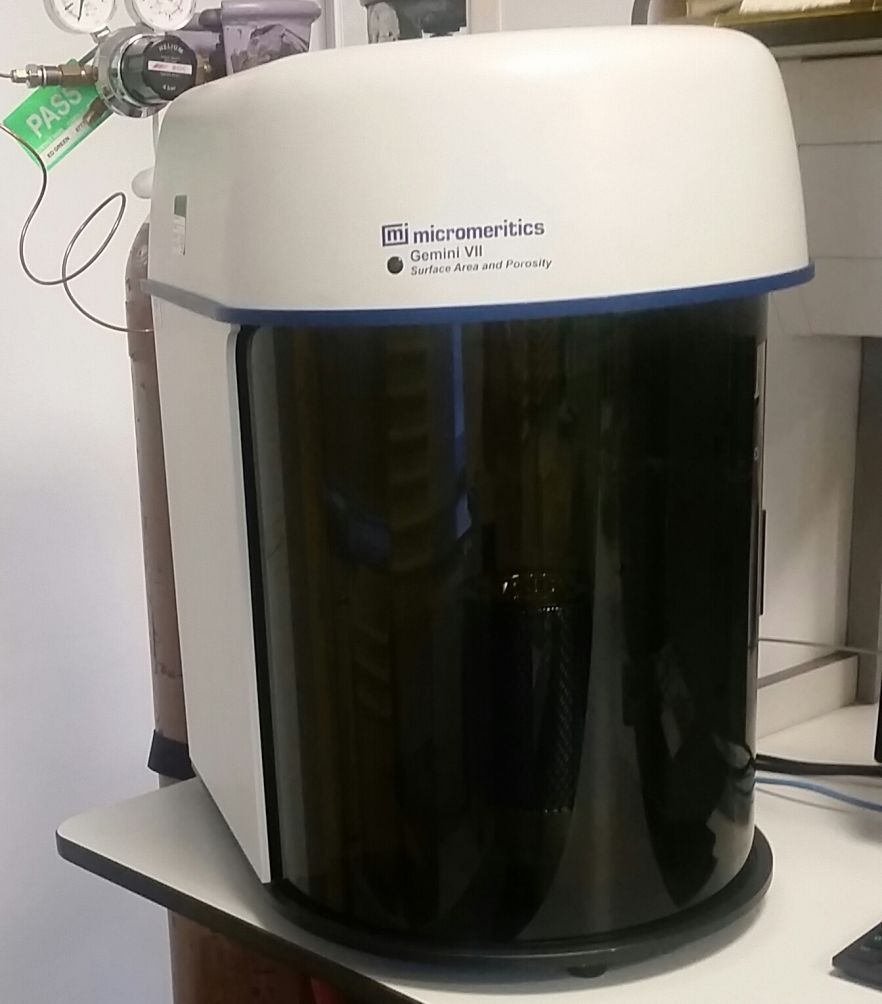Materials Characterisation Lab
Facilities
On this page:
Contact Angle Goniometer (DSA100 KRUSS)
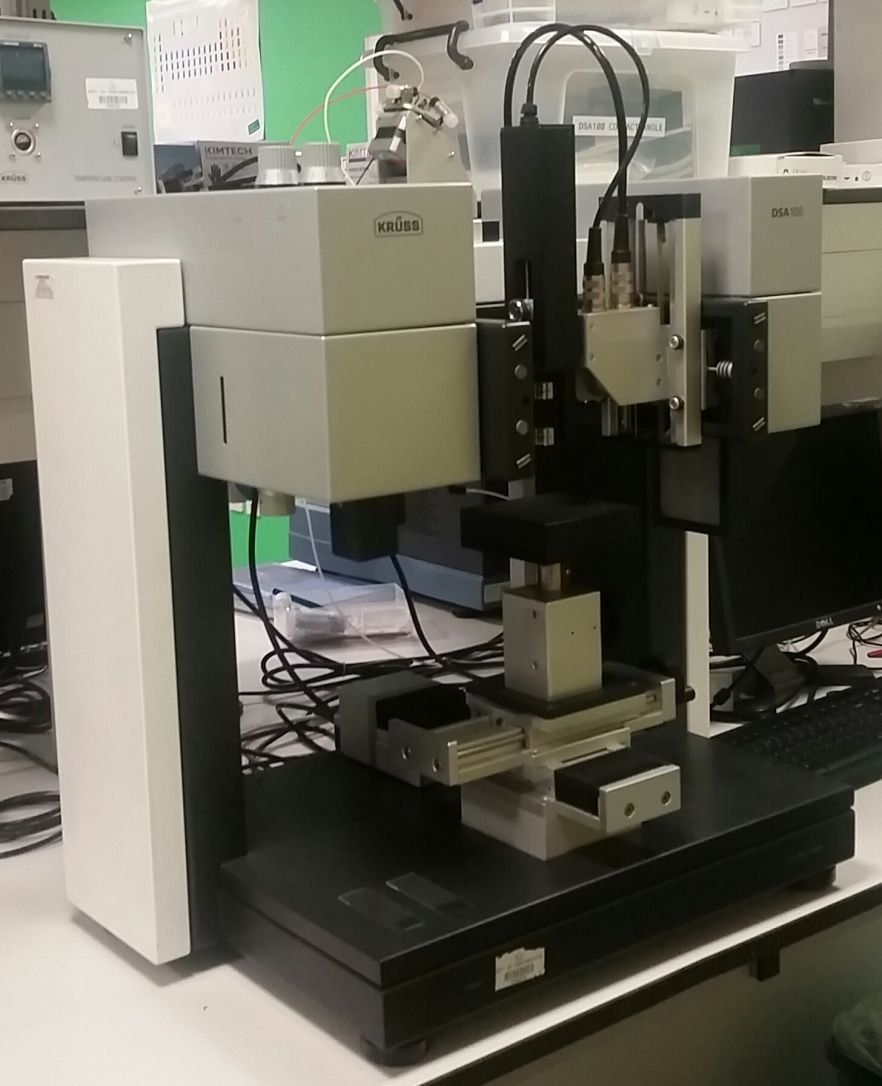
A drop shape analysis (DSA) is an image analysis method for determining the contact angle and surface free energy from the shadow image of a sessile drop and the surface tension or interfacial tension from the shadow image of a pendant drop. The DSA is intended only for measurements of the surface tension of liquids, the interfacial tensions between two liquids and measurement of the contact angle between a liquid and a solid.
Differential Scanning Calorimetry (DSC 25)
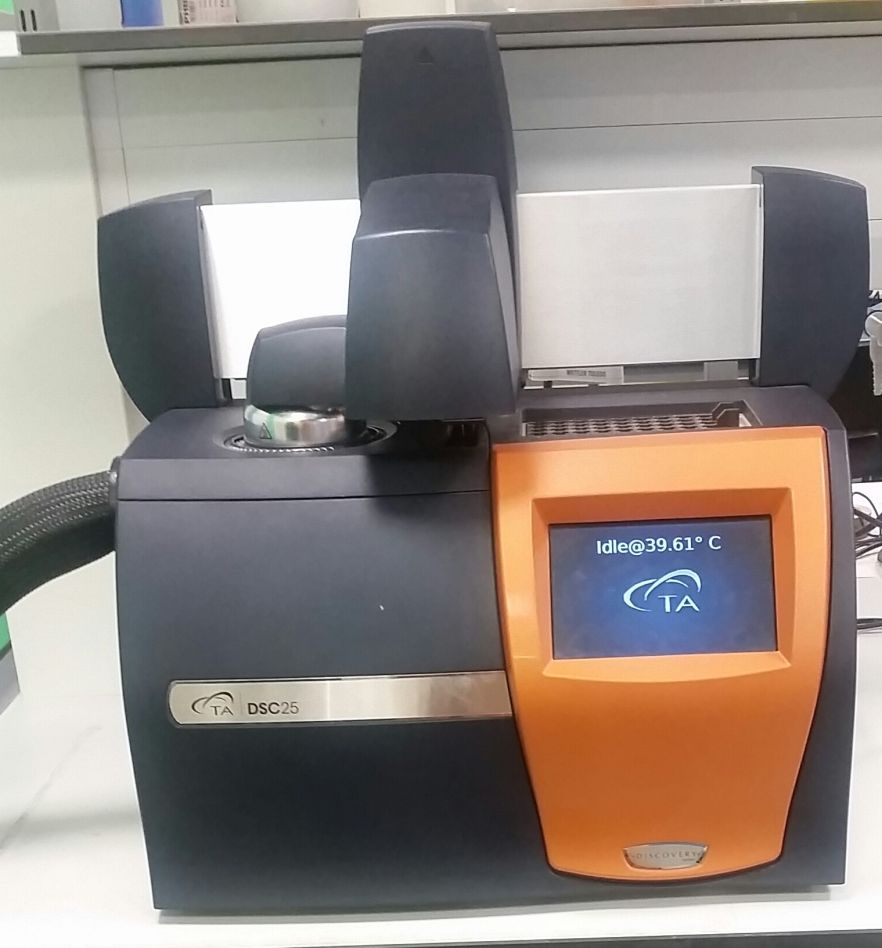 A Differential Scanning Calorimetry (DSC) is used for measuring thermal transitions such as melting point (Tm) and glass transition temperature (Tg). The analysis involves heating a sample over a temperature range from -90 to 400 oC. This DSC is automated (robotic) providing high sample throughput and efficiency.
A Differential Scanning Calorimetry (DSC) is used for measuring thermal transitions such as melting point (Tm) and glass transition temperature (Tg). The analysis involves heating a sample over a temperature range from -90 to 400 oC. This DSC is automated (robotic) providing high sample throughput and efficiency.
Dilatometer (Netzsch 402PC)
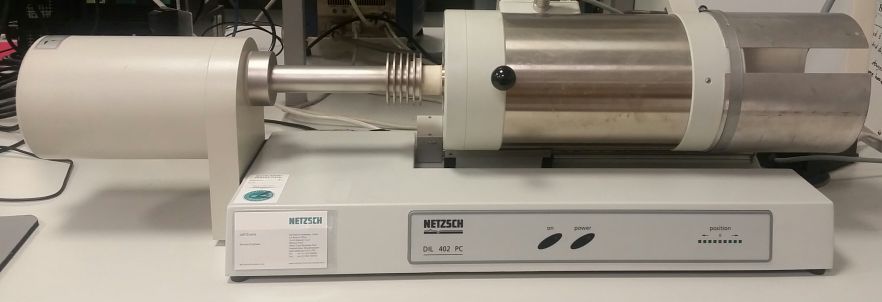 A Dilatometer is used to measure the expansion or contraction of materials from room temperature up to 1600oC to find information about sintering behaviour, thermal expansion or softening point behaviour. It can be used to analyse many different types of materials including: green bodies and clays, ceramics, glasses, polymers and powders.
A Dilatometer is used to measure the expansion or contraction of materials from room temperature up to 1600oC to find information about sintering behaviour, thermal expansion or softening point behaviour. It can be used to analyse many different types of materials including: green bodies and clays, ceramics, glasses, polymers and powders.
Dynamic Mechanical Analyser (DMA-850)
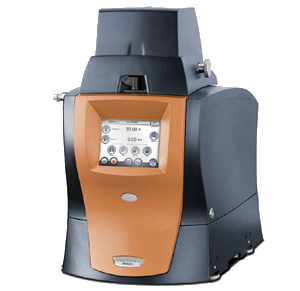
DMA is used to measure visco-elastic properties such as modulus and damping of rigid and soft solid materials. It can measure modulus (elastic) and viscosity (damping) as a function of time, temperature, frequency, stress (or force) and strain (or displacement), or as a combination of these functions.
It can be used with different measuring clamps: single/dual cantilever, 3-point bending, film/fiber tension, shear sandwich, parallel plate compression and submersion compression clamps. It can also be used with a constant force to perform standard thermo-mechanical analysis (TMA). DMA is a liquid nitrogen cooled instrument range from -160 to 600 oC.
Fourier Transform Infrared Spectroscopy (Tensor 27)
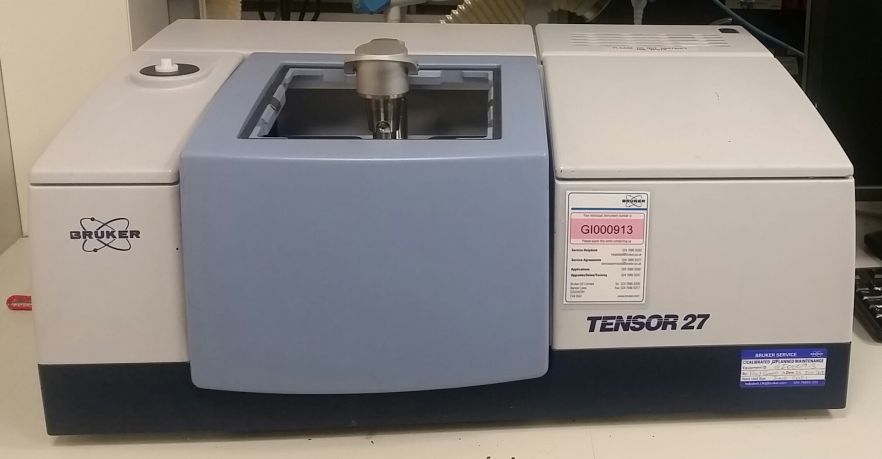 A Fourier Transform infrared Spectroscopy (FTIR) is a technique used to obtain an infrared spectrum of absorption or emission of a large range of liquid and solid samples. TENSOR 27 - the basic spectrometer configuration - is designed for measurements mainly in the mid-infrared region. The sample compartment are purgeable. Purging the spectrometer with dry air or nitrogen gas reduces the content of unwanted atmospheric interferents inside the spectrometer significantly. The sample compartment is equipped with the QuickLock mechanism that allows for an exact and reproducible positioning and locking of various measurement accessories ( ATR, PAS, GIR, TRANS ). Examples of samples that can be analysed are solids, liquids, powders, pastes, pellets, slurries, films and fibers. Wavelength range: 4000-400 cm-1.
A Fourier Transform infrared Spectroscopy (FTIR) is a technique used to obtain an infrared spectrum of absorption or emission of a large range of liquid and solid samples. TENSOR 27 - the basic spectrometer configuration - is designed for measurements mainly in the mid-infrared region. The sample compartment are purgeable. Purging the spectrometer with dry air or nitrogen gas reduces the content of unwanted atmospheric interferents inside the spectrometer significantly. The sample compartment is equipped with the QuickLock mechanism that allows for an exact and reproducible positioning and locking of various measurement accessories ( ATR, PAS, GIR, TRANS ). Examples of samples that can be analysed are solids, liquids, powders, pastes, pellets, slurries, films and fibers. Wavelength range: 4000-400 cm-1.
Fluorescence Spectrometer (Perkin Elmer LS55)
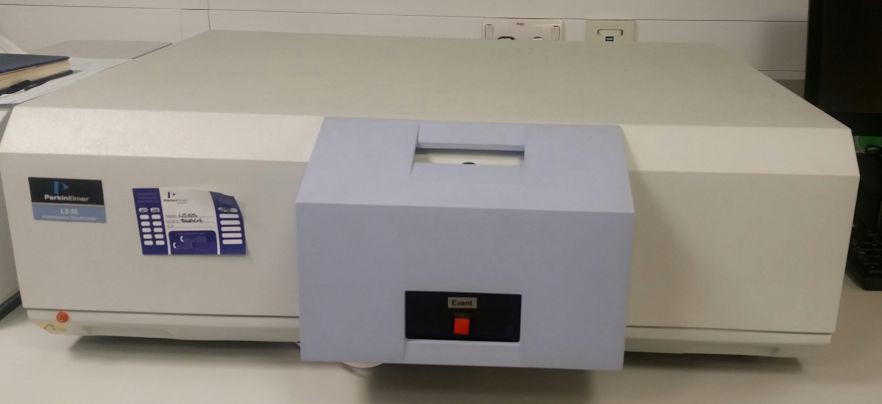 A Fluorescence Spectrometer ( LS55) provides the ultimate blend of high performance, reliability, ease-of-use and versatility. Computer controlled rationing luminescence spectrometer with the capability of measuring fluorescence, phosphorescence, chemiluminescence and bioluminescence. The spectrometer uses a high energy pulsed Xenon source for excitation. Excitation (200-800nm) and emission (200-650 nm) monochromators can be independently or synchronously scanned. Synchronous scanning is available with constant wavelength or constant energy difference.
A Fluorescence Spectrometer ( LS55) provides the ultimate blend of high performance, reliability, ease-of-use and versatility. Computer controlled rationing luminescence spectrometer with the capability of measuring fluorescence, phosphorescence, chemiluminescence and bioluminescence. The spectrometer uses a high energy pulsed Xenon source for excitation. Excitation (200-800nm) and emission (200-650 nm) monochromators can be independently or synchronously scanned. Synchronous scanning is available with constant wavelength or constant energy difference.
Gel Permeation Chromatography (Agilent Technologies 1260 Infinity)
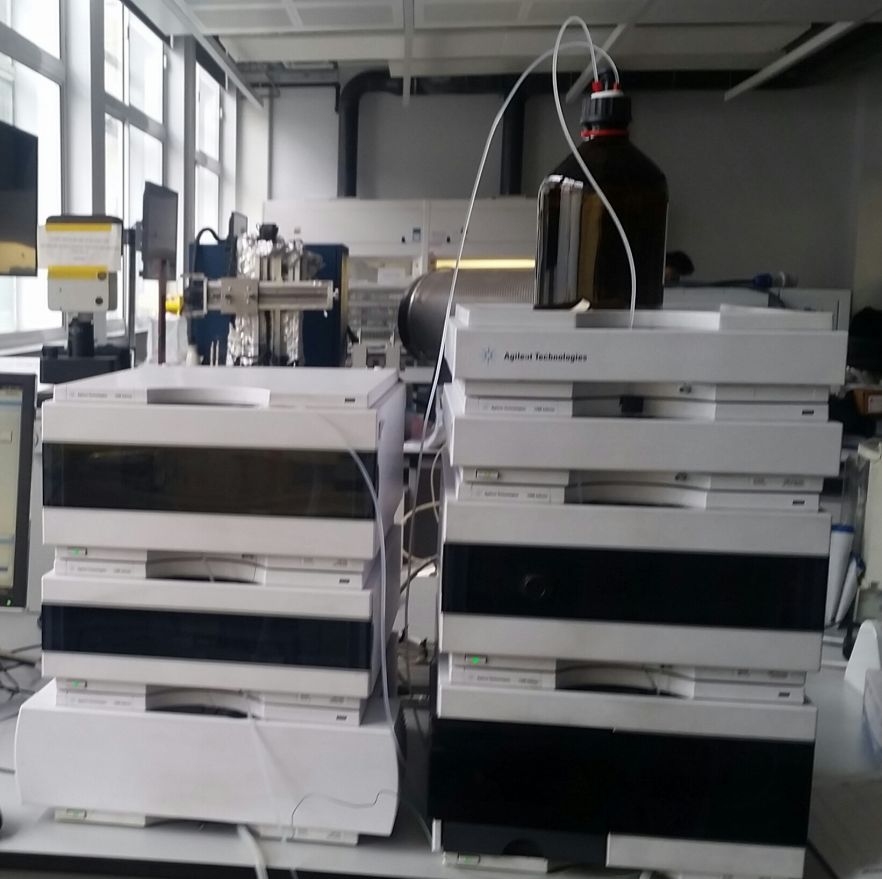 A Gel Permeation Chromatography (GPC) is a technique that used to determine the molecular weight distributions of polymers. GPC uses columns packed with very small, round, porous particles to separate molecules contained in the solvent that is passed through them. It separates molecules on the basis of their size, hence ‘size exclusion’. The GPC system is a cost-effective solution for routine polymer characterization by conventional GPC separation with refractive index, UV-visible or evaporative light scattering detection. The system’s unmatched flow precision and temperature stability gives you the confidence of obtaining reproducible and reliable results.
A Gel Permeation Chromatography (GPC) is a technique that used to determine the molecular weight distributions of polymers. GPC uses columns packed with very small, round, porous particles to separate molecules contained in the solvent that is passed through them. It separates molecules on the basis of their size, hence ‘size exclusion’. The GPC system is a cost-effective solution for routine polymer characterization by conventional GPC separation with refractive index, UV-visible or evaporative light scattering detection. The system’s unmatched flow precision and temperature stability gives you the confidence of obtaining reproducible and reliable results.
Mastersizer (Malvern 3000)
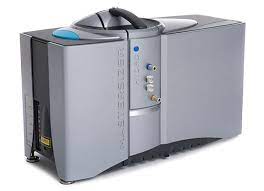 A Mastersizer is a technique allows to measure the size distribution of particles in a liquid medium. The software performs the calculations based on the model chosen, the pattern measured and the inputted particle characteristics. It provides results in the form of volume and number data in addition to the intensity data obtained. It can measure particle sizes from 20 nm to 2 mm.
A Mastersizer is a technique allows to measure the size distribution of particles in a liquid medium. The software performs the calculations based on the model chosen, the pattern measured and the inputted particle characteristics. It provides results in the form of volume and number data in addition to the intensity data obtained. It can measure particle sizes from 20 nm to 2 mm.
Osmometer (Advanced Instruments 3250)
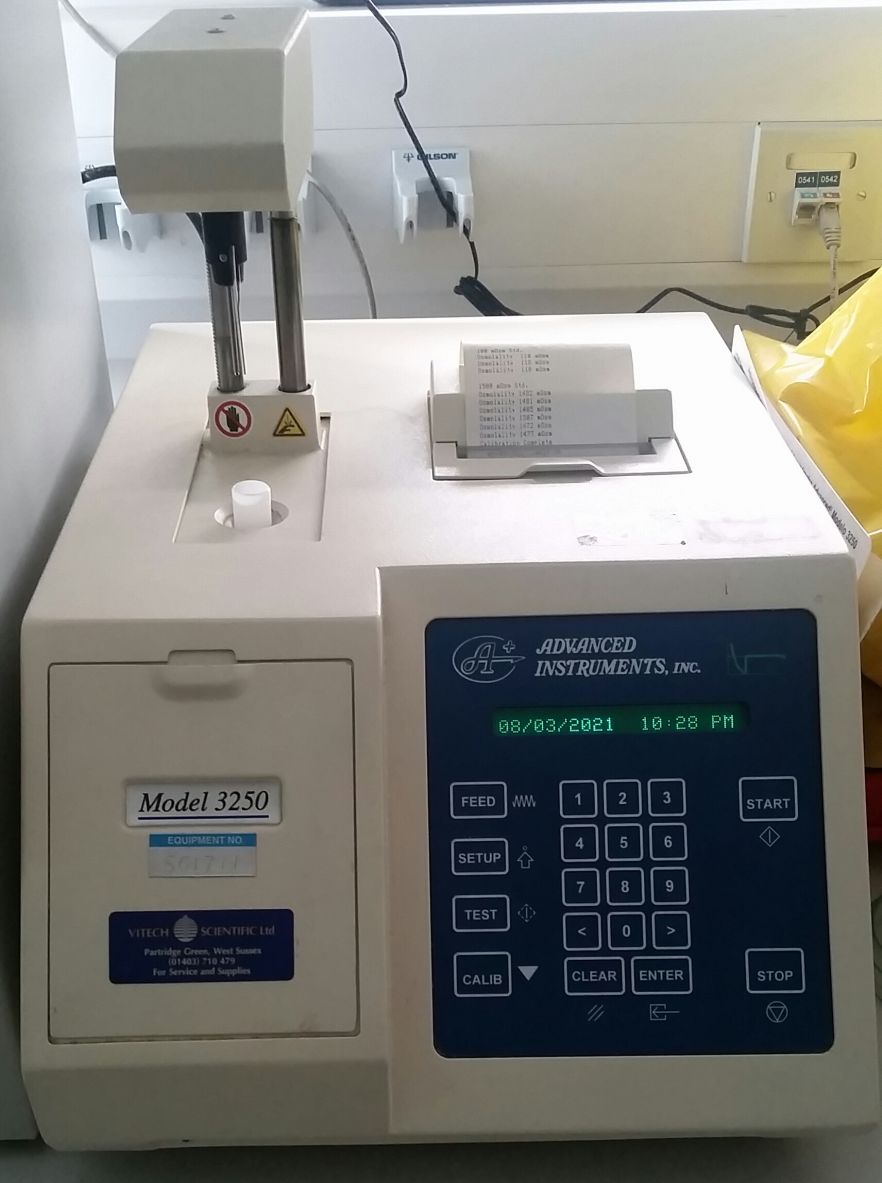 A Osmometer is used to determin the concentration of solutions by means of freezing-point measurement. Advanced Osmometers utilize high-precision thermistors to sense the sample temperature, to control the degree of supercooling and freeze induction, and to measure the freezing point of the sample. They can routinely determine differences of ±1 mOsm/kg H2O. The solution has to be able to freeze. This method is unsuitable for organic solvents.
A Osmometer is used to determin the concentration of solutions by means of freezing-point measurement. Advanced Osmometers utilize high-precision thermistors to sense the sample temperature, to control the degree of supercooling and freeze induction, and to measure the freezing point of the sample. They can routinely determine differences of ±1 mOsm/kg H2O. The solution has to be able to freeze. This method is unsuitable for organic solvents.
Pycnometer (AccuPyc II 1345) 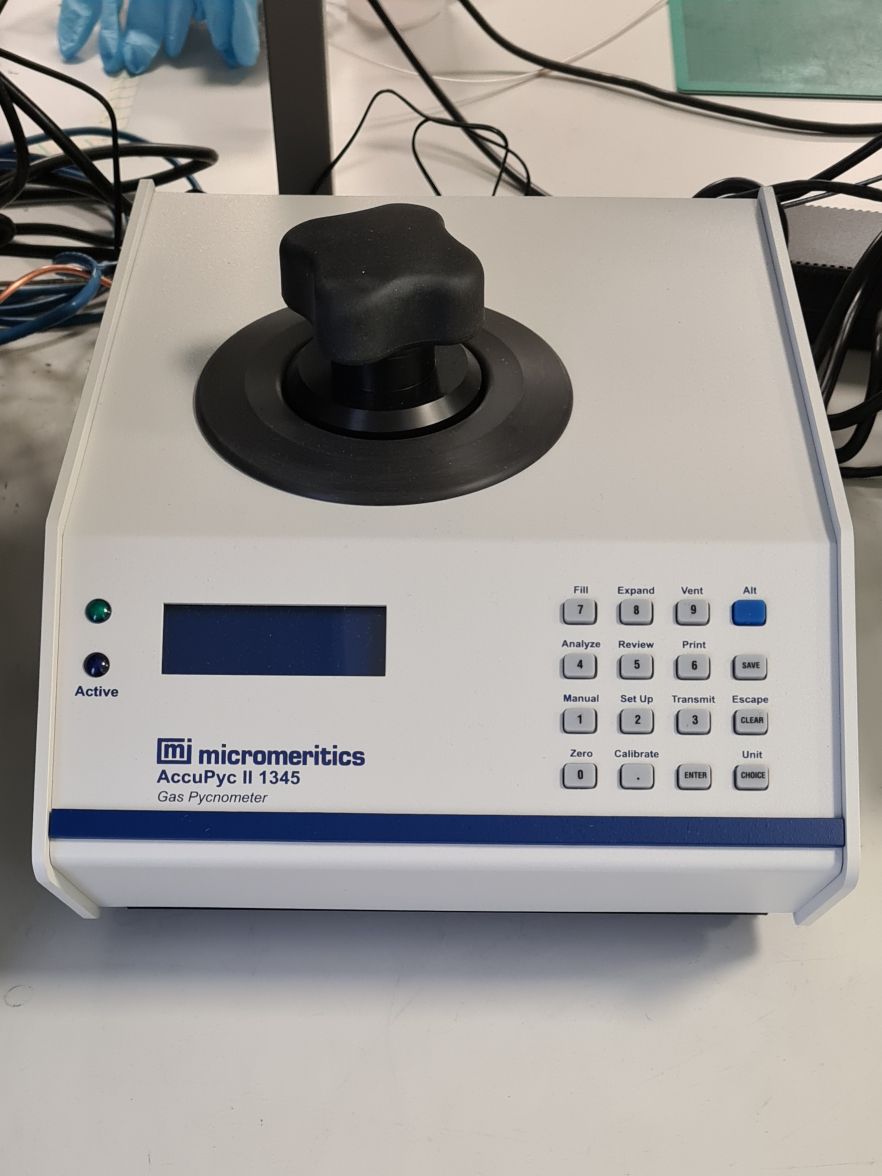
The AccuPyc 1345 pycnometer is an easy to use, fully automatic gas displacement pycnometer. It measures density and volume by measuring the pressure change of helium in a calibrated volume. The analysis measures volume, from which density can be derived automatically if the sample weight has been entered. The AccuPyc has 3 different chamber sizes: 10cm3; 3.5cm3 & 1cm3.
Rheometer ( DHR-3)
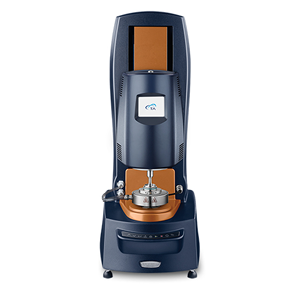
Discovery Hybrid Rheometer.
A Rheometer is a technique that used to study the deformation and flow of materials giving information about elastic and viscoelastic behavior of materials. The rheometer is a controlled stress/controlled rate rheometer capable of handling many different types of samples. The peltier plate can be used between RT and 200oC.
A number of geometries and accessories are available, incluing an Advanced Peltier Plate (A-PP), an Interfacial System and a UV Curing system.
Simultaneous Thermal Analyser (STA 1500)
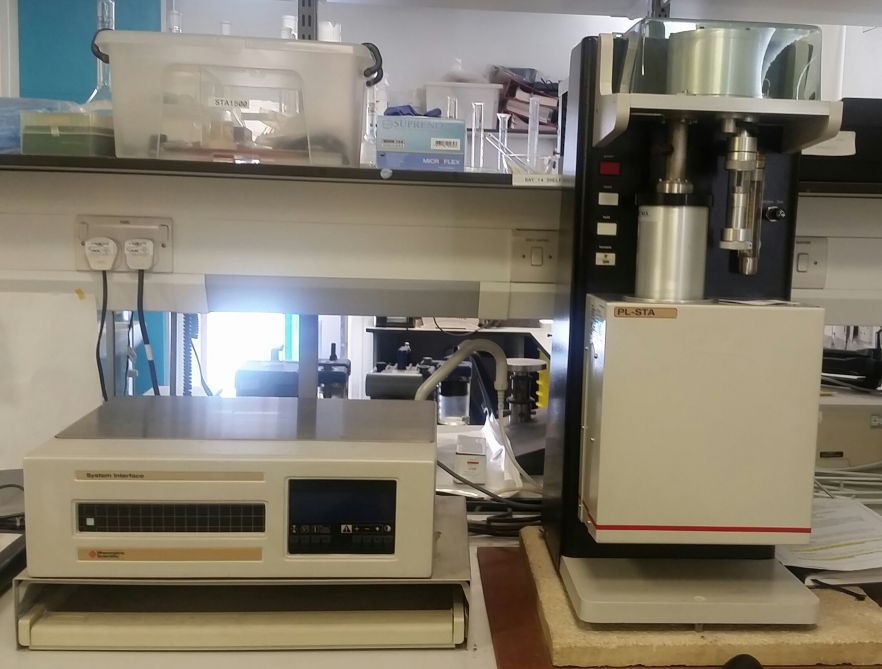 A Simultaneous Thermal Analyser (STA) detects thermal transitions of a sample over a programmed temperature range (RT-1500oC). It has combined DSC and TGA capabilities. It can measure both enthalpy changes (DSC) and weight gain or weight loss (TGA) during sample transitions as a function of temperature or time. The analyser can also be used to gather and analyse data at isothermal temperatures to measure weight loss or gain in sample materials. Samples can be run in nitrogen or air.
A Simultaneous Thermal Analyser (STA) detects thermal transitions of a sample over a programmed temperature range (RT-1500oC). It has combined DSC and TGA capabilities. It can measure both enthalpy changes (DSC) and weight gain or weight loss (TGA) during sample transitions as a function of temperature or time. The analyser can also be used to gather and analyse data at isothermal temperatures to measure weight loss or gain in sample materials. Samples can be run in nitrogen or air.
Surface Area Analyser (Gemini VII 2390 p)
A Surface Area Analyser is a technique that used to determine single and multipoint BET surface area, Langmuir surface area, total pore volume, t-Plot method micropore volume and area, BJH pore size distribution using adsorption isotherm and continuous measurement of saturation pressure (Po). The dry and degassed samples are analysed using nitrogen gas as absorbate.
Surface Area & Pore Size Analyser (NOVA 4200e)
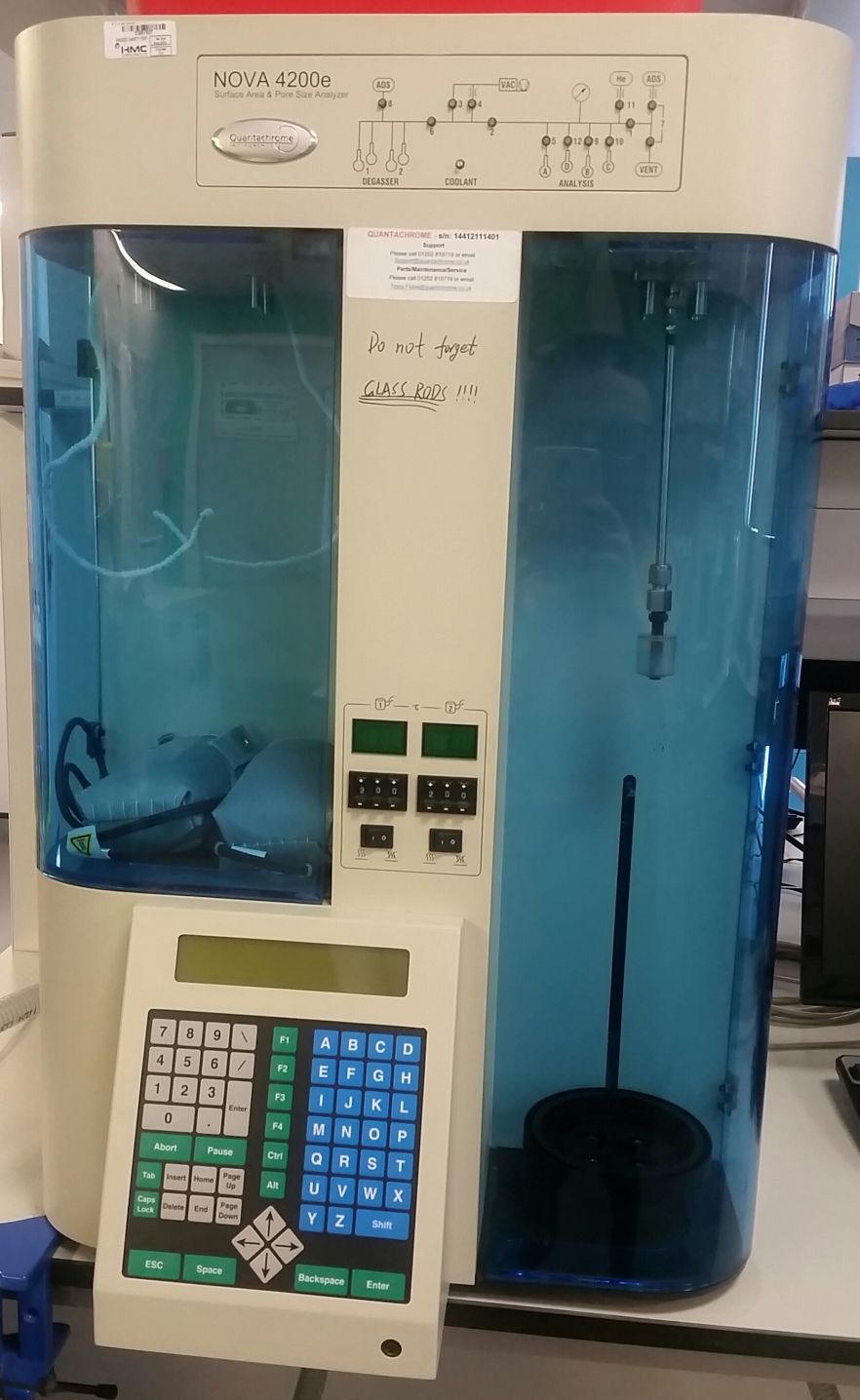 A Surface Area and Pore Size Analyser used to
A Surface Area and Pore Size Analyser used to
- determine fully automated multipoint BET analysis and mesopore size distribution for up to four samples at one time or three plus continuous Po measurement
- prepare two samples by vacuum or flow methods simultaneously with sample analysis—at different temperatures if required.
- access degasser during analysis to start/stop flow or vacuum degassing with Analysis Interrupt.
Surface area range – 0.01 m2/g to not known upper limit
Pore size range- 0.35 to > 500 nm
Temperature range – ambient – 450oC, 1oC intervals
Thermogravimetric Analyser (TGA 5500)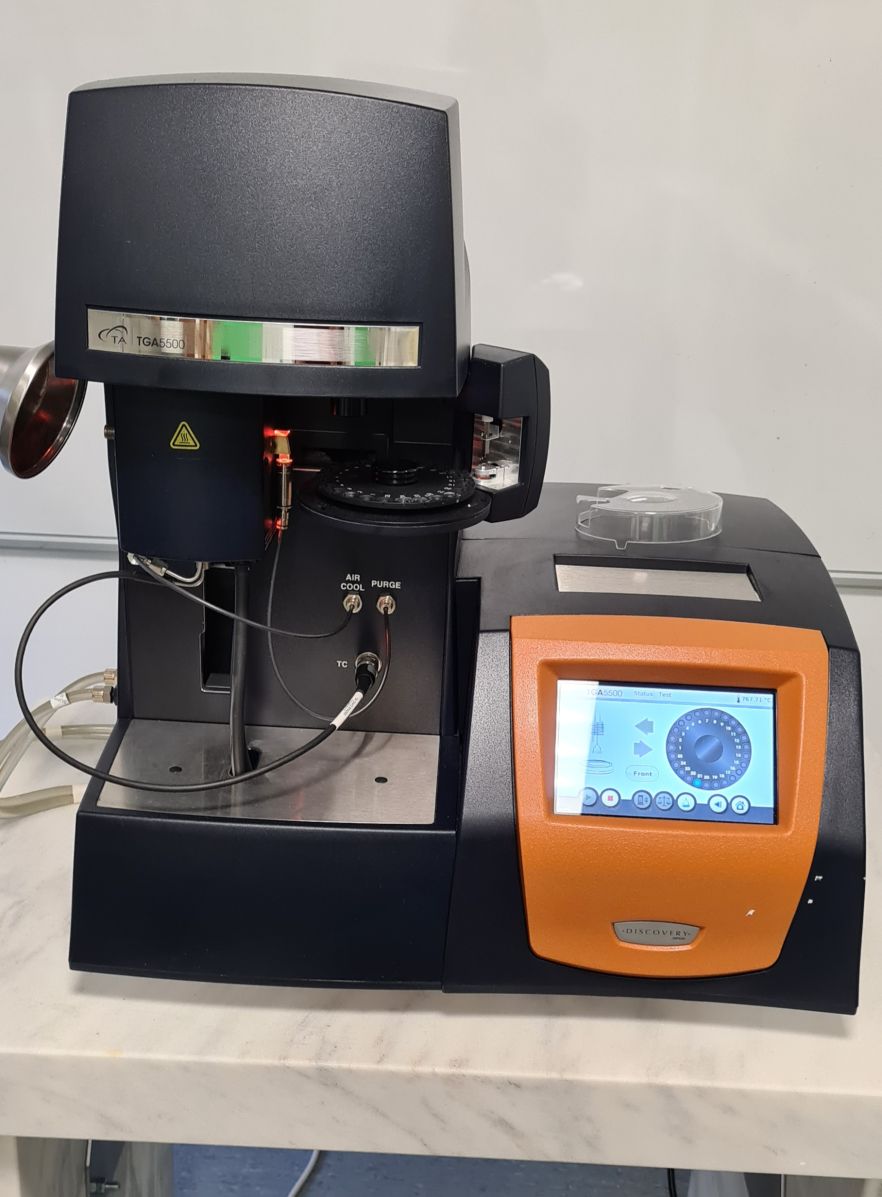
A Thermogravimetric Analyser (TGA) measures the amount and rate of weight change in a material, either as a function of increasing temperature, or isothermally as a function of time, in a controlled atmosphere. It can be used to characterize any material that exhibits a weight change and to detect phase changes due to decomposition, oxidation, or dehydration. This information helps to identify the percent weight structure, processing, and end-use performance. Samples can be heated in nitrogen or air over a programmed temperature range spanning RT-1000oC.
UV-Vis Spectrometer (PerkinElmer Lambda 35)
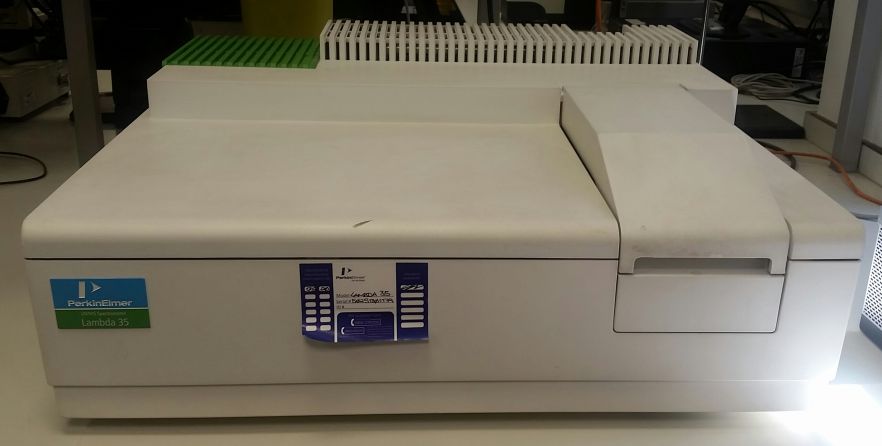 A UV-Vis Spectrometer (Lambda35) is scanning double-beam spectrometer for the UV/Vis range (from 190 to 1100 nm). It is supplied with two photodiodes detectors (one for the sample beam and one for the reference beam). This technique allows liquid and film samples to be characterized in terms of their respective absorption or transmission properties.
A UV-Vis Spectrometer (Lambda35) is scanning double-beam spectrometer for the UV/Vis range (from 190 to 1100 nm). It is supplied with two photodiodes detectors (one for the sample beam and one for the reference beam). This technique allows liquid and film samples to be characterized in terms of their respective absorption or transmission properties.
UV-Vis-NIR Spectrophotometer (PerkinElmer Lambda 950)
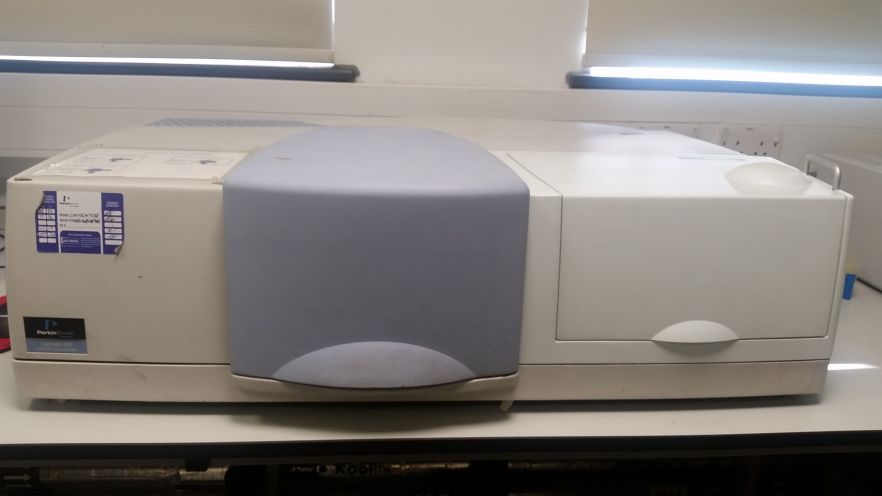 A UV-Vis-NIR Spectrophotometer (Lambda 950) is scanning double-beam spectrophotometer for the UV/Vis/NIR range. It is supplied with two photodiodes detectors (one for the sample beam and one for the reference beam). Lambda 950 allows liquid, solid, film and powder samples to be characterized in terms of their respective absorption, transmission or reflection properties.
A UV-Vis-NIR Spectrophotometer (Lambda 950) is scanning double-beam spectrophotometer for the UV/Vis/NIR range. It is supplied with two photodiodes detectors (one for the sample beam and one for the reference beam). Lambda 950 allows liquid, solid, film and powder samples to be characterized in terms of their respective absorption, transmission or reflection properties.
There are two detectors:
- Standard detector covers a wavelength range from 175 to 3300 nm: suitable for liquid, film or solid samples for transmission or absorption analysis
- Integrating Sphere detector covers a wavelength range from 250 to 2500 nm suitable for films or solids for transmission, absorption and reflection analysis
Zetasizer (Malvern Nano ZS Series)
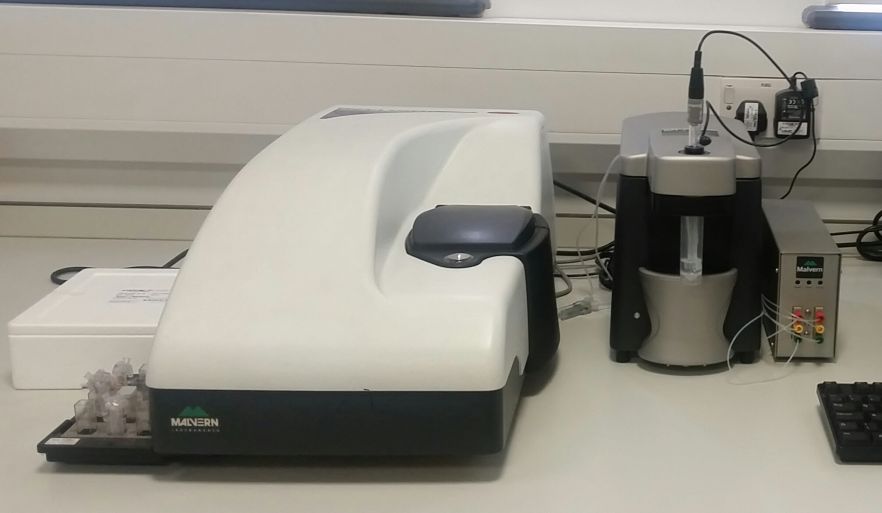 A Zetasizer is a technique allows clear or lightly coloured solutions to be characterized in terms of sample particle size, zeta potential and molecular weight, three fundamental parameters of nano-sized particles or molecules in a liquid medium.
A Zetasizer is a technique allows clear or lightly coloured solutions to be characterized in terms of sample particle size, zeta potential and molecular weight, three fundamental parameters of nano-sized particles or molecules in a liquid medium.
The Zetasizer can measure:
- particle size for the size ranges 0.6 nm to 6 μm
- Zeta potential for a size range 5 nm to 10 μm
- molecular weight in the size ranges 1000 to 2x107 Daltons
- titrator allows to measure zeta potential, size or intensity as a function of pH through a temperature range from 4oC to 90oC.


